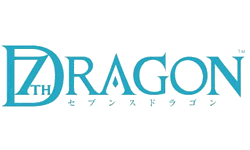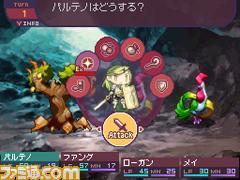|
|

|
PLATFORM
|
DS
|
BATTLE SYSTEM
|

|
INTERACTION
|

|
ORIGINALITY
|

|
STORY
|

|
MUSIC & SOUND
|

|
VISUALS
|

|
CHALLENGE
|
Hard
|
LANGUAGE BARRIER
|
High
|
COMPLETION TIME
|
40-60 Hours
|
|
OVERALL

|
+ Made for hardcore party strategists
+ Great flexibility to character builds
- Needs more dragon types
- Most of the planet is a health hazard
- Final boss difficulty spike
|
Click here for scoring definitions
|
|
|
The company known as imageepoch is now sadly a thing of the past, but that doesn't mean that gamers didn't have high hopes in the beginning. 7th Dragon was developed on behalf of Sega and released in 2009 to much fanfare from the genre enthusiasts. It married the traditional dungeon-crawl combat and character options of a Wizardry clone to a level and overworld format that was closer to Dragon Quest in style, and then served up a heaping helping of dragons to liven things up.
The game begins with the character options, and so shall this review. There are seven job classes to choose from, and four character models for each, covering most color palettes and exemplars of the in-game racial types. Some, like the Fighters and Samurai, are straight-up dealers of physical damage. Others, like the Rogues and Princesses, are masters of sneaky tricks and support skills. Knights and Healers help keep the party afloat in times of adversity, while Mages just blow stuff up.
Within each class, there are plenty of options. At every level up, characters receive one or two skill points which can be used to increase stats or unlock abilities. Any given class can be taken two or three different ways, with lots of variation to please the small-party strategist. Most of the game is beatable with a Knight-Healer-Mage-Other party makeup, but that's hardly the only way to go. It's also possible to re-spec a character by using an amnesia orb, which costs five levels but frees up all the skill points for reassignment. Neither is it too difficult to start a new party member up from scratch, even late in the game. A few dragon nests have the annoying habit of spontaneously respawning after a while, but this is convenient for power-leveling rookies. Some types have skills that interact synergistically with others, like how Fighters can piggyback on a Mage's elemental attacks, or how Knights can cover for a Princess, so experimentation can definitely be interesting.
The only problem for importers is that the densest Japanese phrases in the game all happen to be in the skill detail boxes. Otherwise, this game is remarkably light on the reading level, but most people wouldn't be playing this one for the story anyway.
Now it's time to get to the story. Normally the plot should get mentioned earlier in a review, but this just goes to show how important the narrative is to 7th Dragon as a whole. At the very beginning, the player makes a character, who then forms an adventuring party to take on a few beginner's quests, and then the President tasks them with looking into a strange phenomenon that has overtaken a local forest. Toxic red flowers are growing everywhere, and at the center of it all is the aptly named First Dragon. Once this beastie is dead and the victory celebration has begun, the skies become dark with the wings of his six-hundred-sixty-five friends and relatives. In the initial attack, the player's party is overcome by exposure to the red flowers, and wakes up three years later to a world overcome by the draconic horde. For some reason, everyone thinks that this band of heroes is the only thing able to stem the tide and perhaps even drive away the menace. Of course, the player doesn't even need to use the character made at the very beginning, because the party members have exactly zero impact on anything other than the general dragon population. The major NPCs do their own things in their own scenes, which generally tell the player where to go next and provide some context for the invasion and subsequent reconquest, but in the grand scheme of things most of the plot can be ignored.
 Mighty Knight!
Mighty Knight!
|
|
The side quests in 7th Dragon deserve special attention for all the ways they can be annoying. The game straight-up tells the player at the beginning that quests are things to be sought out by talking to people, but quests can only be formally accepted at a Guild Hall in one of the six major cities. Many quests are connected to NPCs in other parts of the world, however, so very often the player will need to backtrack to another city, speak with a clerk there, then trek all the way back to the original quest-giver to hear just what it is they so desperately need. Sometimes these quests are interesting little diversions, but there are so many "Fetch Item X" quests that the game actually makes jokes about it.
The primary means of getting money in this game is to sell assorted monster bits. This plays into the plethora of fetch quests, and it helps lesson the pain of inventory limitations when the entire point is to sell as much as you can. While there is a spot for money in the post-battle status screen, no monsters actually seem to drop any. This trade in dragon giblets is also central to equipment upgrades. New materials inspire the merchants to try creative things with their products, but by the end of the game this peters out. The last few armor upgrades, for example, require some relatively rare materials, but when unlocked they prove to be either things that were found in treasure chests or were available via the black market twenty hours before. Perhaps sixty percent of the monster bits serve only to provide gold upon sale, and don't even lead to new equipment. This can only be seen as a lost opportunity, as the player's party will likely be using the same general set of equipment for the last third of the game.
 In Soviet Eden, smelling the roses stops you!
In Soviet Eden, smelling the roses stops you!
|
|
One thing of surprising importance in 7th Dragon is the dungeon map. Unlike the Etrian games, to which this title is often compared, the player doesn't draw in the map as the party goes. Instead, maps need to be found or bought, and their value to the party is worth the cost. Specifically, dragons show up on dungeon maps as moving dots. Whenever a fight begins, all dragons in range suddenly have a number on them. That number is how many rounds the party has before they get some very unwelcome company. This can also be put to good use, as it's possible to draw dragons out of otherwise unreachable locations simply by stalling against a weak random monster.
For some reason, it was decided that all the characters needed three styles of art model. Status screen art looks completely different from the bobble-headed combat figures, though the latter does marginally resemble the little sprites who run around town. Monsters in battle are fearsome things, well detailed horrors ranging from bunny rabbits and oversized chickens all the way to the most massive of dragons. With six-hundred sixty-six of the scaly brethren in the game, there are all sorts to be slaughtered: Western dragons, Oriental dragons, dino-dragons, fishy dragons, dragonflies, and others which suggest the graphics team had a few too many drinks one night out in Roppongi.
Actually, that's something that this game could have done more with. The developers should have lifted the half-dragon template straight out of Dungeons & Dragons and just gone to town with it. They already made wolf dragons and beetle dragons, so why not chicken dragons, rabbit dragons, or llama dragons? Not every dragon nest in Eden has its own unique set of dracomorphs, especially later in the game when many areas become available all at once. It gets repetitive, taking on the same drakes over and over again, with only one or two types having enough quirks to justify a modification to the party tactics.
As it stands, 7th Dragon is a game that is specifically geared towards a certain kind of JRPG fan. It's got a highly malleable character build system that lets players take on the worldwide draconquistadores any way they choose. For some people, this could provide hours upon days upon weeks of entertainment. For the rest of us, the game's issues with central plot, motivation, and equipment all conspire to make this a slog to work through.
Review Archives
|









